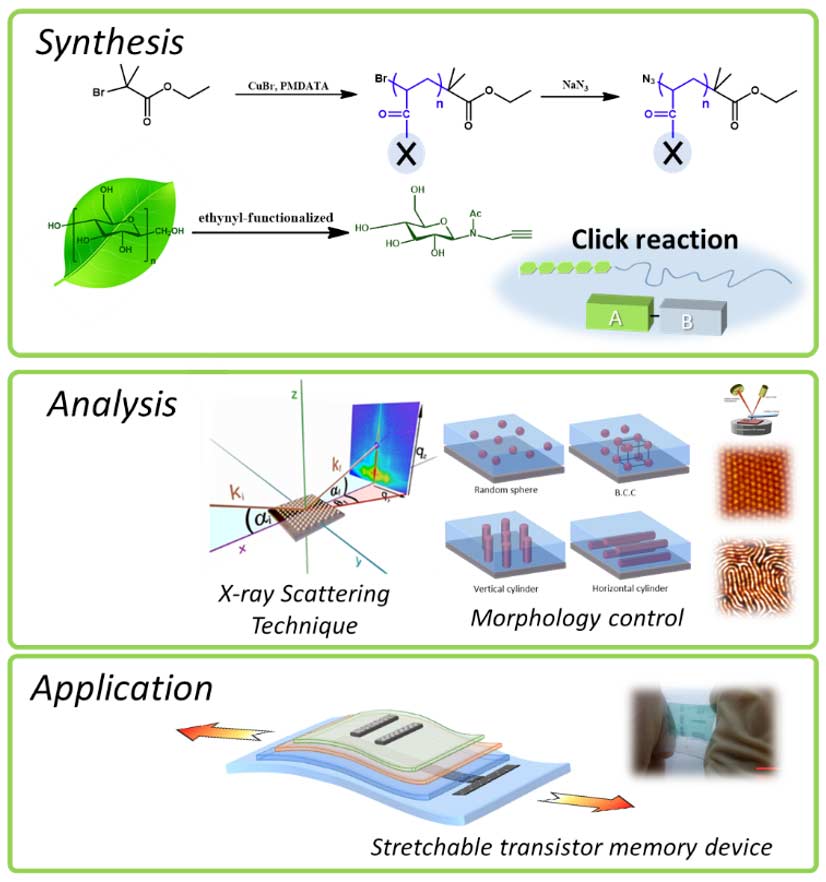Project
Self-Assembly of well-controlled glycopolymers architectures to address their use in bioelectronic devices
Carbohydrates constitute a sustainable source of materials that have attracted a growing interest due to their “green” aspects, biocompatibility, biodegradability, and bio-recognition properties. This is currently attracting much interest in various sectors and their industrial applications at the nano and macroscopic levels is offering new solutions for new biomaterials based on modified carbohydrates and their applications in different sectors ranging from bioelectronics, foods, packaging, cosmetics and health.
This project will be devoted to new developments and studies on the self-assemblies of carbohydrate-based block copolymer leading to new generation of nanoparticles (Glyconanoparticles) and highly nanostructured thin films (sub-10nm resolution) for different stretchable nanobioelectronic devices including memory devices, OLED, OPV.
- Glyconanoparticles (10-500nm) This is a real challenge, strongly motivated by the potentials offered by mimicking Nature and by exploiting, at the nanoscale level, the potential of carbohydrate-based materials towards the developments of novel nanoparticles not expected in shape and applications.
- Highly nanotructured thin films (Sub_10nm): Carbohydrate-based BCPs are particularly unique and interesting as the active layer because of the renewability of its raw materials. These kinds of green BCPs have been reported to form highly-ordered nanostructures with sub-10 nm domain-spacing.
- We aim to develop an efficient and reliable system that make natural molecules into high value added electronic materials (photonic crystals, nanolithography, memory transistors and OLED devices
This collaboration project aims to develop the conception of novel glyconanoparticles and high-performance and environmentally friendly organic memory devices as well as other bioelectronic devices. Post-doctoral and PhD students from both groups (CNRS) and NTU will join this project.
The collaboration in this research project will be divided into two sub-groups:
The French research team of Prof. Borsali will be in charge of the synthesis of functionalized carbohydrates, the target block copolymer and morphology characterization on block copolymer thin films and glyconanoparticles using the microscopy (TEM, Cryo-TEM & SEM) and scattering techniques (SAXS and GISAXS).
On the other hand, the Taiwan research team of Prof. Chen will focus on developing newly-designed high-performance organic-based materials for green stretchable electronics. The work includes nanostructured morphology control, mechanical/physical properties/morphology under strain, stretchable device fabrication and characterization. The results of this collaboration with be promoted through
1)- Educate Young Scholar: We plan to exchange young scholars or graduate students to execute the joint research from three months to one year through the support of MOST/CNRS joint program or Joint University project between NTU and UGA (Univ. Grenoble Alpes). In addition, we want to promote the student exchange and double PhD degree program between NTU and University of Grenoble-Alpes.
2)-Joint Technology Conference and Technology Transfer: we plan to use PolyNat International Industrial Forum (Grenoble, France) and International Green Materials workshop to promote their technology advance & commercial applications in Europe and Asian-Oceanic areas. In addition, French industries in the PolyNat International consortium or the research Taiwanese institute/industry could follow up for the mass production and commercialization of the developed green electronic products
3)-Research Publications and international material conferences



